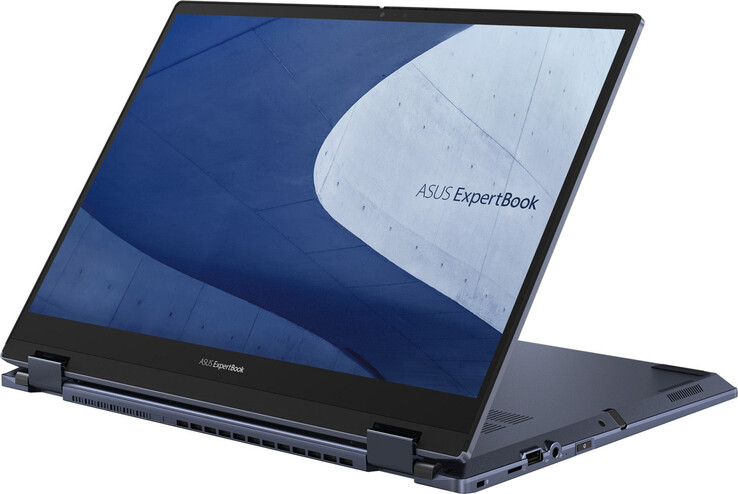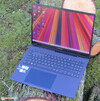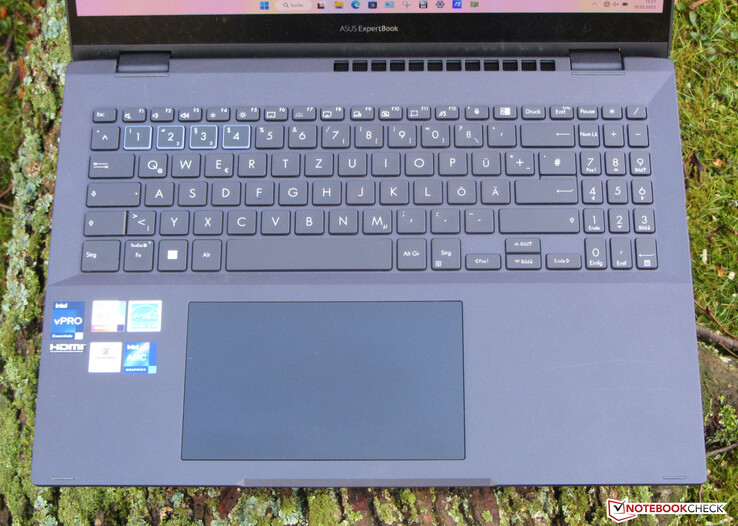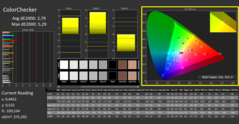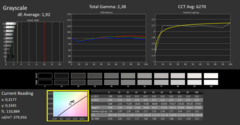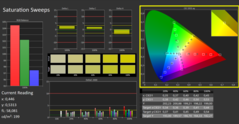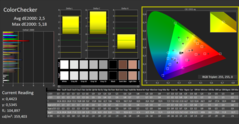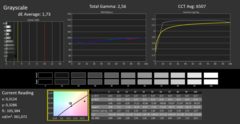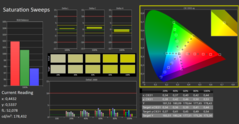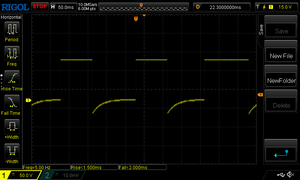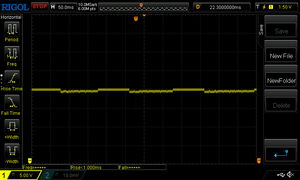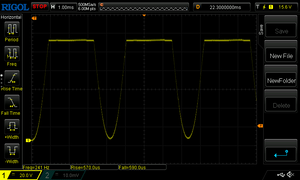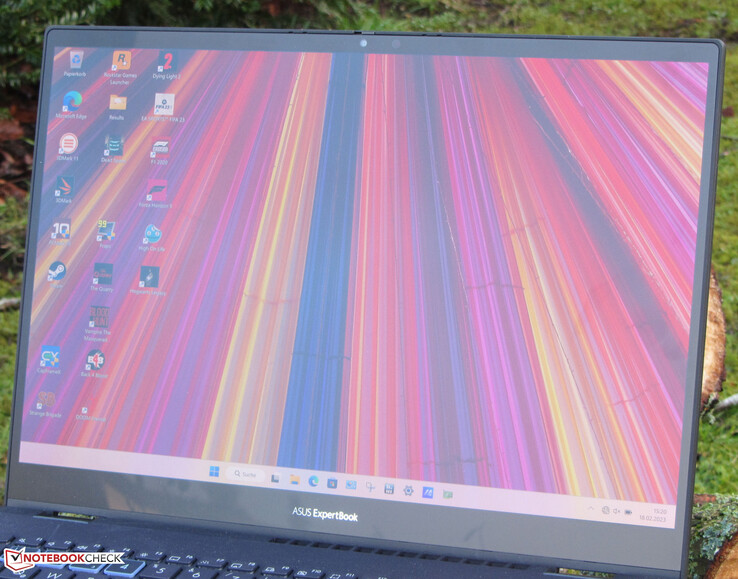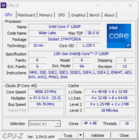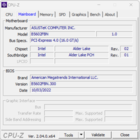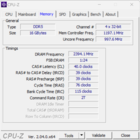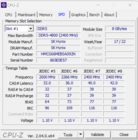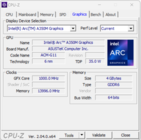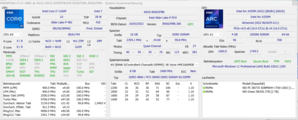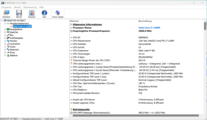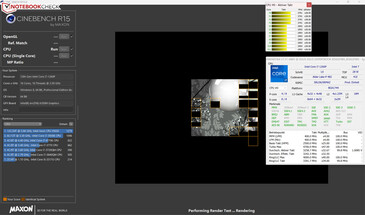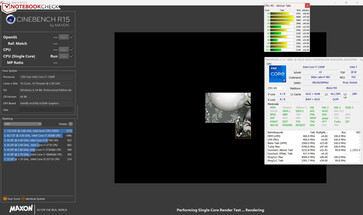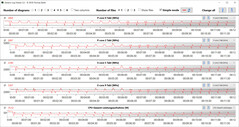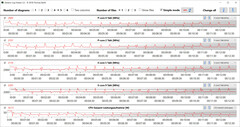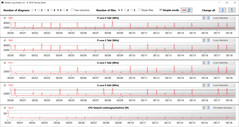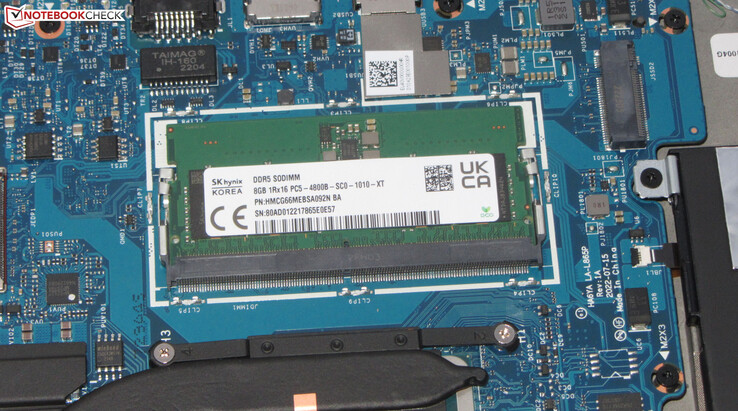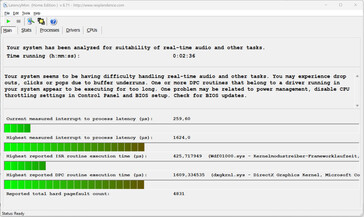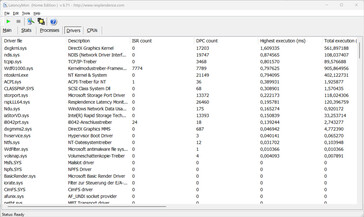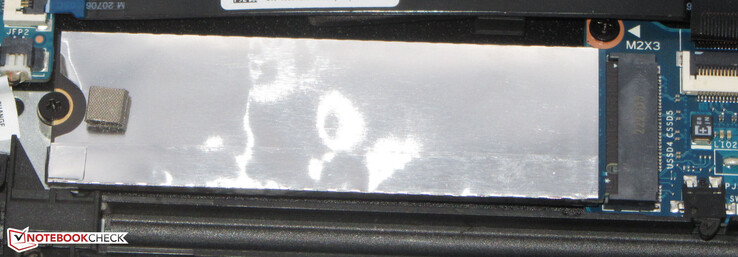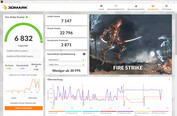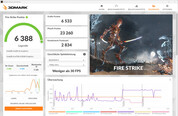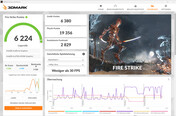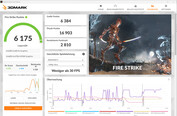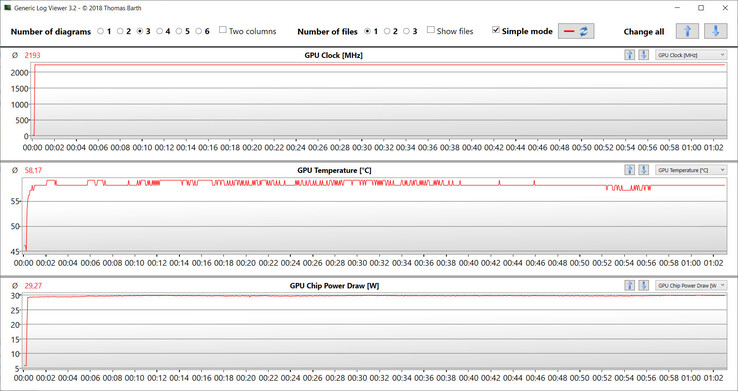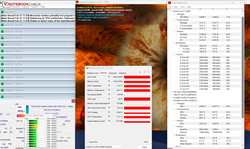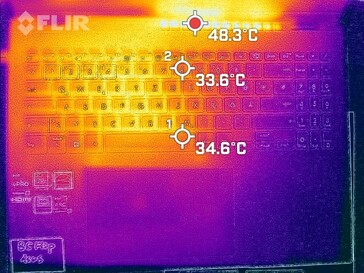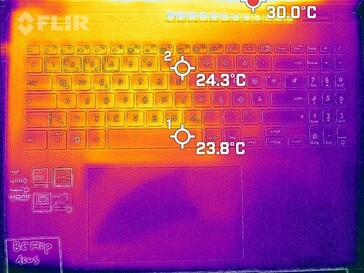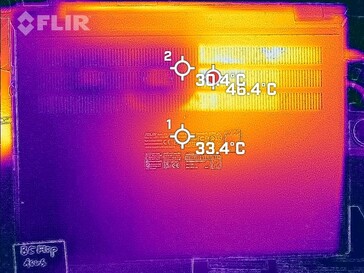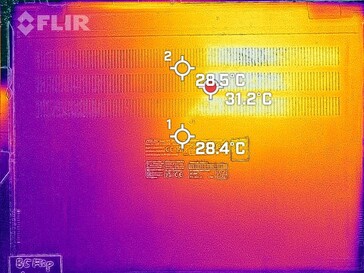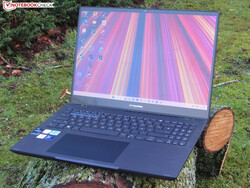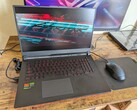Asus ExpertBook B5 Flip OLED in review: 2-in-1 laptop with Active Stylus and good runtimes
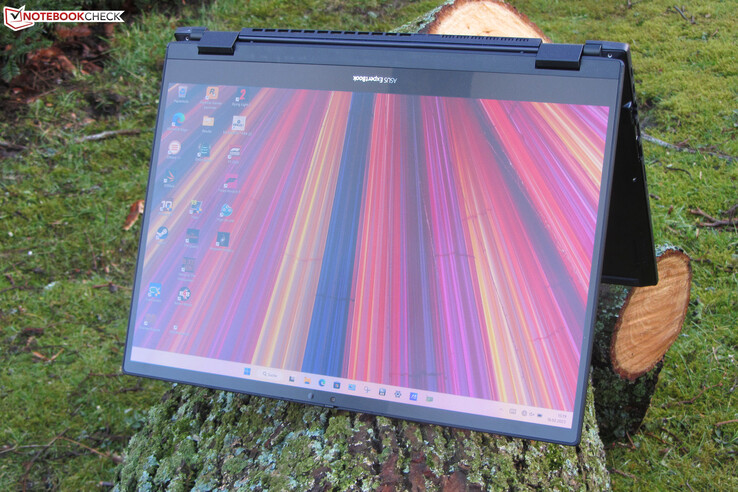
The Asus ExpertBook B5 Flip OLED - a 2-in-1 notebook from the business segment - is powered by a Core i5-1260P CPU and an Arc-A350M GPU - both components come from Intel. Positive: The 16-inch convertible comes with an Active Stylus that is stored and charged in the base unit. The competition includes devices like the HP Spectre x360 16, the Lenovo Yoga 7 16IAP7 and the MSI Summit E16 Flip.
Possible competitors in comparison
Rating | Date | Model | Weight | Height | Size | Resolution | Price |
|---|---|---|---|---|---|---|---|
| 86.5 % v7 (old) | 03 / 2023 | Asus ExpertBook B5 Flip B5602FBN i7-1260P, A350M | 1.8 kg | 19.9 mm | 16.00" | 3840x2400 | |
| 88.7 % v7 (old) | 08 / 2022 | Lenovo Yoga 7 16IAP7 i7-1260P, Iris Xe G7 96EUs | 2 kg | 19.2 mm | 16.00" | 2560x1600 | |
| 87.3 % v7 (old) | 01 / 2023 | HP Spectre x360 2-in-1 16-f1075ng i7-12700H, Iris Xe G7 96EUs | 2 kg | 19.9 mm | 16.00" | 3072x1920 | |
| 84.2 % v7 (old) | 10 / 2022 | MSI Summit E16 Flip A12UDT-031 i7-1280P, GeForce RTX 3050 Ti Laptop GPU | 1.9 kg | 16.85 mm | 16.00" | 2560x1600 |
Case & equipment - business convertible offers Thunderbolt 4
The quite light notebook (approx. 1.8 kg/~4 lb) does not reveal any manufacturing flaws. The lid and base unit can be twisted a bit - the whole thing is completely within limits. The innards are accessible after removing the base unit. Asus relies on a matte-black metal chassis with dull surfaces.
The B5 offers two USB-A ports (1x USB 3.2 Gen 2, 1x USB 2.0) and two USB-C ports (2x Thunderbolt 4; Power Delivery, Displayport). Up to 3 external monitors (1x HDMI, 2x DP) could be connected. The microSD memory card reader (reference card: AV PRO microSD 128 GB V60) is one of the slow models. Good: The webcam (2.1 MP, max. 1,920 x 1,080 pixels) has a mechanical cover.
The WLAN transfer rates determined under optimal conditions (no other WLAN devices in the near vicinity, short distance between notebook and server PC) turn out excellent.
| SD Card Reader | |
| average JPG Copy Test (av. of 3 runs) | |
| MSI Summit E16 Flip A12UDT-031 (AV Pro SD microSD 128 GB V60) | |
| HP Spectre x360 2-in-1 16-f1075ng | |
| Lenovo Yoga 7 16IAP7 (Toshiba Exceria Pro SDXC 64 GB UHS-II) | |
| Average of class Convertible (28.1 - 209, n=23, last 2 years) | |
| Asus ExpertBook B5 Flip B5602FBN (AV Pro SD microSD 128 GB V60) | |
| maximum AS SSD Seq Read Test (1GB) | |
| MSI Summit E16 Flip A12UDT-031 (AV Pro SD microSD 128 GB V60) | |
| HP Spectre x360 2-in-1 16-f1075ng | |
| Average of class Convertible (28.9 - 253, n=22, last 2 years) | |
| Lenovo Yoga 7 16IAP7 (Toshiba Exceria Pro SDXC 64 GB UHS-II) | |
| Asus ExpertBook B5 Flip B5602FBN (AV Pro SD microSD 128 GB V60) | |
Input devices - Asus gives the B5 Flip an Active Stylus
The keys of the splash-proof, illuminated chiclet keyboard offer a medium travel and a clear pressure point. The key resistance is okay. The keyboard's minimal yielding at best did not prove to be annoying. All in all, it is a keyboard suitable for everyday use.
The smooth surface of the multi-touch capable clickpad (approx. 15 x 9.1 cm/~5.9 x 3.6 in) makes it easy for the fingers to glide. The pad responds to inputs in the corners, has a short stroke and offers a clear pressure point.
Display - Great black value thanks to OLED
The matte-reflective surface (AntiGlare coating) of the 16-inch OLED touchscreen (3,840 x 2,400 pixels) in the work-friendly 16:10 format reduces reflections significantly, but does not prevent them completely.
As typical for OLEDs, the panel shines with an excellent contrast and black value. However, it also scores with short response times and relatively high maximum brightness.
The brightness is regulated by darkening individual stripes within the displayed screen content. In the case of the B5 panel, this happens with a quite low frequency of 240 Hz at brightness levels ≤ 50 percent. This effect is similar to the well-known PWM flickering, but it is not directly comparable.
| |||||||||||||||||||||||||
Brightness Distribution: 98 %
Center on Battery: 380 cd/m²
Contrast: 37900:1 (Black: 0.01 cd/m²)
ΔE ColorChecker Calman: 2.79 | ∀{0.5-29.43 Ø4.79}
calibrated: 2.5
ΔE Greyscale Calman: 1.92 | ∀{0.09-98 Ø5}
97.1% AdobeRGB 1998 (Argyll 3D)
100% sRGB (Argyll 3D)
71.7% Display P3 (Argyll 3D)
Gamma: 2.38
CCT: 6270 K
| Asus ExpertBook B5 Flip B5602FBN Samsung ATNA60YV02-0, OLED, 3840x2400, 16" | Lenovo Yoga 7 16IAP7 Lenovo LEN160WQXGA, IPS, 2560x1600, 16" | HP Spectre x360 2-in-1 16-f1075ng AU Optronics AUO50A3, IPS, 3072x1920, 16" | MSI Summit E16 Flip A12UDT-031 AU Optronics B16QAN02.N, IPS, 2560x1600, 16" | |
|---|---|---|---|---|
| Display | -13% | -5% | 9% | |
| Display P3 Coverage (%) | 71.7 | 67 -7% | 75.6 5% | 98.9 38% |
| sRGB Coverage (%) | 100 | 95.7 -4% | 100.2 0% | 100 0% |
| AdobeRGB 1998 Coverage (%) | 97.1 | 69.3 -29% | 77.2 -20% | 86.5 -11% |
| Response Times | -1420% | -1900% | -450% | |
| Response Time Grey 50% / Grey 80% * (ms) | 2 ? | 36 ? -1700% | 52 ? -2500% | 13 ? -550% |
| Response Time Black / White * (ms) | 2 ? | 24.8 ? -1140% | 28 ? -1300% | 9 ? -350% |
| PWM Frequency (Hz) | 240 ? | |||
| Screen | -413% | -330% | -323% | |
| Brightness middle (cd/m²) | 379 | 393.7 4% | 425 12% | 314 -17% |
| Brightness (cd/m²) | 382 | 367 -4% | 406 6% | 294 -23% |
| Brightness Distribution (%) | 98 | 84 -14% | 78 -20% | 89 -9% |
| Black Level * (cd/m²) | 0.01 | 0.38 -3700% | 0.24 -2300% | 0.28 -2700% |
| Contrast (:1) | 37900 | 1036 -97% | 1771 -95% | 1121 -97% |
| Colorchecker dE 2000 * | 2.79 | 1.97 29% | 5.8 -108% | 3.08 -10% |
| Colorchecker dE 2000 max. * | 5.29 | 5.46 -3% | 11.03 -109% | 5.49 -4% |
| Colorchecker dE 2000 calibrated * | 2.5 | 0.62 75% | 4.16 -66% | 0.88 65% |
| Greyscale dE 2000 * | 1.92 | 2.1 -9% | 7.57 -294% | 3.99 -108% |
| Gamma | 2.38 92% | 2.1 105% | 6600 0% | 2.3 96% |
| CCT | 6270 104% | 6461 101% | 6219 105% | |
| Total Average (Program / Settings) | -615% /
-471% | -745% /
-485% | -255% /
-270% |
* ... smaller is better
The panel's X-Rite Pantone certification ensures a natural color representation: With a deviation of 2.8, the target (DeltaE < 3) is already met in the delivery state. A calibration provides minor improvements. The display can reproduce the sRGB and Adobe color space completely or almost completely, and the DCI-P3 color space is reproduced by 72%.
Display Response Times
| ↔ Response Time Black to White | ||
|---|---|---|
| 2 ms ... rise ↗ and fall ↘ combined | ↗ 1 ms rise | |
| ↘ 1 ms fall | ||
| The screen shows very fast response rates in our tests and should be very well suited for fast-paced gaming. In comparison, all tested devices range from 0.1 (minimum) to 240 (maximum) ms. » 9 % of all devices are better. This means that the measured response time is better than the average of all tested devices (20.3 ms). | ||
| ↔ Response Time 50% Grey to 80% Grey | ||
| 2 ms ... rise ↗ and fall ↘ combined | ↗ 1 ms rise | |
| ↘ 1 ms fall | ||
| The screen shows very fast response rates in our tests and should be very well suited for fast-paced gaming. In comparison, all tested devices range from 0.165 (minimum) to 636 (maximum) ms. » 8 % of all devices are better. This means that the measured response time is better than the average of all tested devices (31.7 ms). | ||
Screen Flickering / PWM (Pulse-Width Modulation)
| Screen flickering / PWM detected | 240 Hz | ≤ 50 % brightness setting | |
The display backlight flickers at 240 Hz (worst case, e.g., utilizing PWM) Flickering detected at a brightness setting of 50 % and below. There should be no flickering or PWM above this brightness setting. The frequency of 240 Hz is relatively low, so sensitive users will likely notice flickering and experience eyestrain at the stated brightness setting and below. In comparison: 53 % of all tested devices do not use PWM to dim the display. If PWM was detected, an average of 8152 (minimum: 5 - maximum: 343500) Hz was measured. | |||
Performance - The Asus computer runs on Intel hardware
The ExpertBook B5 Flip series stands for 2-in-1 laptops from the business segment. Alder Lake CPUs are used within the series. Optionally, models with dedicated Intel Arc-A350M GPU - our review sample is one of them.
Test conditions
It is possible to switch between the three manufacturer-specific fan modes (see table) via the key combination "Fn" + "F". The "performance mode" (benchmarks) and the "whisper mode" (battery test) were used. The former is only available in mains operation. The modes influence the CPU and GPU performance.
| Power mode | Standard mode | Whisper mode | |
|---|---|---|---|
| Power Limit 1 | 35 Watt | 35 Watt | 18 Watt |
| Power Limit 2 | 64 Watt | 64 Watt | 64 Watt |
Processor
The Core i7-1260P-Processor (Alder Lake) consists of four performance cores (hyperthreading, 2.1 to 4.7 GHz) and eight efficiency cores (no hyperthreading, 1.5 to 3.4 GHz). In total, this results in 16 logical CPU cores. The CPU delivers above-average benchmark results.
The multi-thread test of the Cinebench R15 benchmark is processed with 3.8 GHz (P cores) and 3 GHz (E cores), respectively. The single-thread test is run with 2.2 to 4.7 GHz (P cores) and 1.5 to 3.4 GHz (E cores). The clock rates are lower in battery mode. The CB15 loop test shows: Multi-thread load is only met with a high Turbo clock for a short time. After a few seconds, the rates drop to a medium level at best.
Cinebench R15 Multi Endurance test
* ... smaller is better
AIDA64: FP32 Ray-Trace | FPU Julia | CPU SHA3 | CPU Queen | FPU SinJulia | FPU Mandel | CPU AES | CPU ZLib | FP64 Ray-Trace | CPU PhotoWorxx
| Performance rating | |
| MSI Summit E16 Flip A12UDT-031 | |
| HP Spectre x360 2-in-1 16-f1075ng | |
| Average of class Convertible | |
| Asus ExpertBook B5 Flip B5602FBN | |
| Lenovo Yoga 7 16IAP7 | |
| Average Intel Core i7-1260P | |
| AIDA64 / FP32 Ray-Trace | |
| MSI Summit E16 Flip A12UDT-031 | |
| Average of class Convertible (1480 - 64158, n=56, last 2 years) | |
| HP Spectre x360 2-in-1 16-f1075ng | |
| Asus ExpertBook B5 Flip B5602FBN | |
| Lenovo Yoga 7 16IAP7 | |
| Average Intel Core i7-1260P (2176 - 10898, n=26) | |
| AIDA64 / FPU Julia | |
| MSI Summit E16 Flip A12UDT-031 | |
| Average of class Convertible (11392 - 183760, n=56, last 2 years) | |
| HP Spectre x360 2-in-1 16-f1075ng | |
| Asus ExpertBook B5 Flip B5602FBN | |
| Lenovo Yoga 7 16IAP7 | |
| Average Intel Core i7-1260P (11015 - 56906, n=26) | |
| AIDA64 / CPU SHA3 | |
| MSI Summit E16 Flip A12UDT-031 | |
| Average of class Convertible (797 - 8151, n=56, last 2 years) | |
| HP Spectre x360 2-in-1 16-f1075ng | |
| Asus ExpertBook B5 Flip B5602FBN | |
| Lenovo Yoga 7 16IAP7 | |
| Average Intel Core i7-1260P (669 - 2709, n=26) | |
| AIDA64 / CPU Queen | |
| MSI Summit E16 Flip A12UDT-031 | |
| HP Spectre x360 2-in-1 16-f1075ng | |
| Asus ExpertBook B5 Flip B5602FBN | |
| Lenovo Yoga 7 16IAP7 | |
| Average Intel Core i7-1260P (42571 - 82493, n=26) | |
| Average of class Convertible (14686 - 145339, n=56, last 2 years) | |
| AIDA64 / FPU SinJulia | |
| MSI Summit E16 Flip A12UDT-031 | |
| HP Spectre x360 2-in-1 16-f1075ng | |
| Average of class Convertible (1120 - 29155, n=56, last 2 years) | |
| Asus ExpertBook B5 Flip B5602FBN | |
| Average Intel Core i7-1260P (2901 - 6975, n=26) | |
| Lenovo Yoga 7 16IAP7 | |
| AIDA64 / FPU Mandel | |
| MSI Summit E16 Flip A12UDT-031 | |
| Average of class Convertible (4929 - 97193, n=56, last 2 years) | |
| HP Spectre x360 2-in-1 16-f1075ng | |
| Asus ExpertBook B5 Flip B5602FBN | |
| Lenovo Yoga 7 16IAP7 | |
| Average Intel Core i7-1260P (5950 - 26376, n=26) | |
| AIDA64 / CPU AES | |
| HP Spectre x360 2-in-1 16-f1075ng | |
| MSI Summit E16 Flip A12UDT-031 | |
| Average of class Convertible (15752 - 139734, n=56, last 2 years) | |
| Asus ExpertBook B5 Flip B5602FBN | |
| Average Intel Core i7-1260P (16041 - 92356, n=26) | |
| Lenovo Yoga 7 16IAP7 | |
| AIDA64 / CPU ZLib | |
| MSI Summit E16 Flip A12UDT-031 | |
| HP Spectre x360 2-in-1 16-f1075ng | |
| Average of class Convertible (218 - 2001, n=56, last 2 years) | |
| Asus ExpertBook B5 Flip B5602FBN | |
| Lenovo Yoga 7 16IAP7 | |
| Average Intel Core i7-1260P (259 - 771, n=26) | |
| AIDA64 / FP64 Ray-Trace | |
| MSI Summit E16 Flip A12UDT-031 | |
| Average of class Convertible (1169 - 34297, n=56, last 2 years) | |
| HP Spectre x360 2-in-1 16-f1075ng | |
| Asus ExpertBook B5 Flip B5602FBN | |
| Lenovo Yoga 7 16IAP7 | |
| Average Intel Core i7-1260P (1237 - 5858, n=26) | |
| AIDA64 / CPU PhotoWorxx | |
| Lenovo Yoga 7 16IAP7 | |
| Average of class Convertible (14193 - 81626, n=56, last 2 years) | |
| MSI Summit E16 Flip A12UDT-031 | |
| Asus ExpertBook B5 Flip B5602FBN | |
| Average Intel Core i7-1260P (13261 - 43652, n=26) | |
| HP Spectre x360 2-in-1 16-f1075ng | |
System performance
The smoothly running system offers enough performance for office and Internet applications as well as gaming. GPU-heavy applications benefit from the dedicated graphics core. The working memory delivers transfer rates on a normal level for DDR5-4800 memory. In addition, there are very good PCMark results.
CrossMark: Overall | Productivity | Creativity | Responsiveness
| PCMark 10 / Score | |
| Average of class Convertible (3229 - 9125, n=54, last 2 years) | |
| MSI Summit E16 Flip A12UDT-031 | |
| HP Spectre x360 2-in-1 16-f1075ng | |
| Lenovo Yoga 7 16IAP7 | |
| Asus ExpertBook B5 Flip B5602FBN | |
| Average Intel Core i7-1260P, Intel Arc A350M (5486 - 5609, n=2) | |
| PCMark 10 / Essentials | |
| Lenovo Yoga 7 16IAP7 | |
| HP Spectre x360 2-in-1 16-f1075ng | |
| Average of class Convertible (7233 - 12222, n=54, last 2 years) | |
| Average Intel Core i7-1260P, Intel Arc A350M (9411 - 9997, n=2) | |
| MSI Summit E16 Flip A12UDT-031 | |
| Asus ExpertBook B5 Flip B5602FBN | |
| PCMark 10 / Productivity | |
| Average of class Convertible (5062 - 10643, n=54, last 2 years) | |
| MSI Summit E16 Flip A12UDT-031 | |
| HP Spectre x360 2-in-1 16-f1075ng | |
| Lenovo Yoga 7 16IAP7 | |
| Asus ExpertBook B5 Flip B5602FBN | |
| Average Intel Core i7-1260P, Intel Arc A350M (6714 - 6728, n=2) | |
| PCMark 10 / Digital Content Creation | |
| Average of class Convertible (2496 - 16551, n=54, last 2 years) | |
| MSI Summit E16 Flip A12UDT-031 | |
| Asus ExpertBook B5 Flip B5602FBN | |
| HP Spectre x360 2-in-1 16-f1075ng | |
| Average Intel Core i7-1260P, Intel Arc A350M (6677 - 7562, n=2) | |
| Lenovo Yoga 7 16IAP7 | |
| CrossMark / Overall | |
| HP Spectre x360 2-in-1 16-f1075ng | |
| Asus ExpertBook B5 Flip B5602FBN | |
| Average Intel Core i7-1260P, Intel Arc A350M (n=1) | |
| Lenovo Yoga 7 16IAP7 | |
| MSI Summit E16 Flip A12UDT-031 | |
| Average of class Convertible (524 - 2274, n=57, last 2 years) | |
| CrossMark / Productivity | |
| HP Spectre x360 2-in-1 16-f1075ng | |
| Asus ExpertBook B5 Flip B5602FBN | |
| Average Intel Core i7-1260P, Intel Arc A350M (n=1) | |
| Lenovo Yoga 7 16IAP7 | |
| MSI Summit E16 Flip A12UDT-031 | |
| Average of class Convertible (554 - 1925, n=57, last 2 years) | |
| CrossMark / Creativity | |
| Lenovo Yoga 7 16IAP7 | |
| MSI Summit E16 Flip A12UDT-031 | |
| Asus ExpertBook B5 Flip B5602FBN | |
| Average Intel Core i7-1260P, Intel Arc A350M (n=1) | |
| Average of class Convertible (550 - 2949, n=57, last 2 years) | |
| HP Spectre x360 2-in-1 16-f1075ng | |
| CrossMark / Responsiveness | |
| HP Spectre x360 2-in-1 16-f1075ng | |
| Asus ExpertBook B5 Flip B5602FBN | |
| Average Intel Core i7-1260P, Intel Arc A350M (n=1) | |
| MSI Summit E16 Flip A12UDT-031 | |
| Lenovo Yoga 7 16IAP7 | |
| Average of class Convertible (381 - 1719, n=57, last 2 years) | |
| PCMark 10 Score | 5609 points | |
Help | ||
| AIDA64 / Memory Copy | |
| Average of class Convertible (23880 - 158525, n=56, last 2 years) | |
| Lenovo Yoga 7 16IAP7 | |
| MSI Summit E16 Flip A12UDT-031 | |
| Average Intel Core i7-1260P (25125 - 71544, n=25) | |
| Asus ExpertBook B5 Flip B5602FBN | |
| HP Spectre x360 2-in-1 16-f1075ng | |
| AIDA64 / Memory Read | |
| Average of class Convertible (19931 - 126725, n=56, last 2 years) | |
| Lenovo Yoga 7 16IAP7 | |
| MSI Summit E16 Flip A12UDT-031 | |
| Average Intel Core i7-1260P (24983 - 72065, n=25) | |
| Asus ExpertBook B5 Flip B5602FBN | |
| HP Spectre x360 2-in-1 16-f1075ng | |
| AIDA64 / Memory Write | |
| Average of class Convertible (17473 - 216896, n=56, last 2 years) | |
| Lenovo Yoga 7 16IAP7 | |
| MSI Summit E16 Flip A12UDT-031 | |
| Average Intel Core i7-1260P (23512 - 66799, n=25) | |
| Asus ExpertBook B5 Flip B5602FBN | |
| HP Spectre x360 2-in-1 16-f1075ng | |
| AIDA64 / Memory Latency | |
| MSI Summit E16 Flip A12UDT-031 | |
| Average of class Convertible (6.9 - 536, n=55, last 2 years) | |
| Lenovo Yoga 7 16IAP7 | |
| Asus ExpertBook B5 Flip B5602FBN | |
| Average Intel Core i7-1260P (77.9 - 118.4, n=21) | |
| HP Spectre x360 2-in-1 16-f1075ng | |
* ... smaller is better
| DPC Latencies / LatencyMon - interrupt to process latency (max), Web, Youtube, Prime95 | |
| Asus ExpertBook B5 Flip B5602FBN | |
| HP Spectre x360 2-in-1 16-f1075ng | |
| MSI Summit E16 Flip A12UDT-031 | |
| Lenovo Yoga 7 16IAP7 | |
* ... smaller is better
Mass storage
The B5 offers space for two PCIe-4 SSDs in M.2-2280 format. RAID 0/1 is supported. The installed PCIe-4 SSD (1 TB) delivers good transfer rates, but it is not one of the top SSD models. Performance drops due to thermal throttling do not occur.
* ... smaller is better
Continuous Reading: DiskSpd Read Loop, Queue Depth 8
Graphics card
With the Arc-A350M GPU, the weakest representative from Intel's current DGPU portfolio has found its way into the B5 Flip. The entry-level model has a TGP of 35 watts, can rely on fast GDDR6 memory (4.096 GB) and reaches a maximum clock of 2.2 GHz - the latter can be maintained permanently according to the Witcher 3 test.
The A350M often scores better than its direct rivals in the synthetic benchmarks (GeForce MX550, Radeon 680M), but is often at a disadvantage in gaming practice - with higher energy requirements. Nevertheless, the GPU is suitable for gaming at medium to partly high settings.
The mixed gaming performance is offset by other advantages of the A350M, which should be more in demand in a laptop like the B5 Flip: ray tracing cores, high OpenCL performance and support for the AV1 codec (de- and encoding).
More information about the performance of the Arc A350M and its direct rivals can be found in a technology article: Battle of the entry-level GPUs - Nvidia GeForce MX550 & Intel Arc A350M in test.
| 3DMark 11 Performance | 11409 points | |
| 3DMark Cloud Gate Standard Score | 23965 points | |
| 3DMark Fire Strike Score | 6832 points | |
| 3DMark Time Spy Score | 3397 points | |
Help | ||
| GPUScore: Sacred Path | |
| 2560x1440 Official VRS | |
| Average of class Convertible (12.5 - 122.8, n=176, last 2 years) | |
| Asus ExpertBook B5 Flip B5602FBN (0.9.0 Vulkan 1.3) | |
| Asus ExpertBook B5 Flip B5602FBN (0.9.0 DirectX 12) | |
| Average Intel Arc A350M (17.3 - 34, n=2) | |
| HP Spectre x360 2-in-1 16-f1075ng (0.9.0 Vulkan 1.3) | |
| 2560x1440 Official | |
| Average of class Convertible (2.85 - 119.2, n=215, last 2 years) | |
| Asus ExpertBook B5 Flip B5602FBN (0.9.0 Vulkan 1.3) | |
| Asus ExpertBook B5 Flip B5602FBN (0.9.0 DirectX 12) | |
| Average Intel Arc A350M (16.4 - 34.1, n=2) | |
| HP Spectre x360 2-in-1 16-f1075ng (0.9.0 DirectX 12) | |
| V-Ray 5 Benchmark | |
| GPU CUDA | |
| MSI Summit E16 Flip A12UDT-031 (5.0.1) | |
| Average of class Convertible (177 - 993, n=3, last 2 years) | |
| Minisforum Venus Series UM690 (5.0.1) | |
| Asus ExpertBook B5 Flip B5602FBN (5.0.1) | |
| Average Intel Arc A350M (n=1) | |
| CPU | |
| Minisforum Venus Series UM690 (5.0.1) | |
| Average of class Convertible (5002 - 22310, n=33, last 2 years) | |
| Asus ExpertBook B5 Flip B5602FBN (5.0.1) | |
| Average Intel Arc A350M (n=1) | |
| MSI Summit E16 Flip A12UDT-031 (5.0.1) | |
| Lenovo Yoga 7 16IAP7 (5.0.1) | |
| V-Ray Benchmark Next 4.10 | |
| GPU | |
| MSI Summit E16 Flip A12UDT-031 (v4.10.07 ) | |
| Minisforum Venus Series UM690 (v4.10.07 ) | |
| Lenovo IdeaCentre AIO 3 24IAP7 (v4.10.07 ) | |
| HP Spectre x360 2-in-1 16-f1075ng (v4.10.07 ) | |
| Asus ExpertBook B5 Flip B5602FBN (v4.10.07 ) | |
| Average of class Convertible (17 - 179, n=45, last 2 years) | |
| Average Intel Arc A350M (56 - 64, n=2) | |
| CPU | |
| Minisforum Venus Series UM690 (v4.10.07 ) | |
| HP Spectre x360 2-in-1 16-f1075ng (v4.10.07 ) | |
| Lenovo IdeaCentre AIO 3 24IAP7 (v4.10.07 ) | |
| Asus ExpertBook B5 Flip B5602FBN (v4.10.07 ) | |
| MSI Summit E16 Flip A12UDT-031 (v4.10.07 ) | |
| Average of class Convertible (2486 - 33834, n=45, last 2 years) | |
| Average Intel Arc A350M (10932 - 11372, n=2) | |
* ... smaller is better
| The Witcher 3 - 1920x1080 High Graphics & Postprocessing (Nvidia HairWorks Off) | |
| MSI Summit E16 Flip A12UDT-031 | |
| Lenovo IdeaCentre AIO 3 24IAP7 | |
| Asus ExpertBook B5 Flip B5602FBN | |
| Minisforum Venus Series UM690 | |
| Average of class Convertible (21.4 - 120.1, n=20, last 2 years) | |
| Lenovo Yoga 7 16IAP7 | |
| HP Spectre x360 2-in-1 16-f1075ng | |
| GTA V - 1920x1080 High/On (Advanced Graphics Off) AA:2xMSAA + FX AF:8x | |
| MSI Summit E16 Flip A12UDT-031 | |
| Lenovo IdeaCentre AIO 3 24IAP7 | |
| Minisforum Venus Series UM690 | |
| Average of class Convertible (6.88 - 166.9, n=43, last 2 years) | |
| Asus ExpertBook B5 Flip B5602FBN | |
| Lenovo Yoga 7 16IAP7 | |
| HP Spectre x360 2-in-1 16-f1075ng | |
Witcher 3 FPS-Diagram
| low | med. | high | ultra | QHD | 4K | |
|---|---|---|---|---|---|---|
| GTA V (2015) | 170.7 | 156.3 | 38 | 15.2 | 10.1 | 11.1 |
| The Witcher 3 (2015) | 140.1 | 83.6 | 45 | 20.5 | 15.1 | |
| Dota 2 Reborn (2015) | 102.1 | 85.8 | 60.6 | 56.1 | ||
| Final Fantasy XV Benchmark (2018) | 64.8 | 33.2 | 18.2 | 13.6 | 7.33 | |
| X-Plane 11.11 (2018) | 43.9 | 32.2 | 27.9 | 19.6 | ||
| Far Cry 5 (2018) | 89 | 44 | 41 | 38 | 25 | 12 |
| Strange Brigade (2018) | 163.4 | 71.6 | 58.7 | 49.1 | 36.6 | 19.6 |
| The Division 2 (2019) | 92 | 46 | 37 | 27 | 17 | 7 |
| Doom Eternal (2020) | 113.4 | 55.6 | ||||
| Flight Simulator 2020 (2020) | 43.1 | |||||
| Assassin´s Creed Valhalla (2020) | 65 | 35 | 20 | 16 | 14 | |
| Back 4 Blood (2021) | 139.3 | 60.2 | 48.1 | 46 | 31 | 14.9 |
| Riders Republic (2021) | 60 | 32 | 25 | 21 | 12 | 7 |
| Forza Horizon 5 (2021) | 108 | 50 | 47 | 11 | 9 | 6 |
| Rainbow Six Extraction (2022) | 68 | 52 | 45 | 30 | 17 | 2.6 |
| Dying Light 2 (2022) | 26.7 | 21.9 | 17.8 | |||
| Vampire Bloodhunt (2022) | 80.6 | 64.7 | 54.9 | 49.9 | 30.6 | 10.8 |
| F1 22 (2022) | 52.1 | 51.4 | 35.5 | |||
| A Plague Tale Requiem (2022) | 29.9 | 24.3 | 20 | 13.1 | 6.4 | |
| Call of Duty Modern Warfare 2 2022 (2022) | 41 | 37 | 23 | 12 | 7 | 6 |
| Spider-Man Miles Morales (2022) | 41.5 | 33.2 | 25.4 | 20.4 | 14.7 | 7.22 |
| The Callisto Protocol (2022) | 42.1 | 28.3 | 12.3 | 13.9 | 8.3 | 3.1 |
| High On Life (2023) | 71.9 | 42.6 | 38.2 | 27.8 | 18.8 | 4.36 |
| The Witcher 3 v4 (2023) | 56.3 | 42.6 | 36.1 | 29.7 | 20.4 | |
| Hogwarts Legacy (2023) | 37.5 | 25 | 19.8 | 15.3 | 10.1 | 2.96 |
Emissions & energy - 2-in-1 notebook with good endurance rates
Noise emissions
The B5602FBN produces an acceptable noise level overall. Idle and everyday use (office, Internet) is often silent. Under full load (stress test, Witcher 3 test), the sound pressure level can rise up to 53.6 dB (A) - too high a value. Using the fan profile "Whisper mode" lowers the noise development overall - at the expense of the computing performance.
Noise level
| Idle |
| 27.5 / 27.5 / 28.3 dB(A) |
| Load |
| 40.7 / 53.6 dB(A) |
 | ||
30 dB silent 40 dB(A) audible 50 dB(A) loud |
||
min: | ||
| Asus ExpertBook B5 Flip B5602FBN A350M, i7-1260P, WD PC SN735 SDBPNHH-1T00 | Lenovo Yoga 7 16IAP7 Iris Xe G7 96EUs, i7-1260P, Micron 2450 512GB MTFDKCD512TFK | HP Spectre x360 2-in-1 16-f1075ng Iris Xe G7 96EUs, i7-12700H, SK Hynix PC711 1TB HFS001TDE9X073N | MSI Summit E16 Flip A12UDT-031 GeForce RTX 3050 Ti Laptop GPU, i7-1280P, Samsung PM9A1 MZVL22T0HBLB | |
|---|---|---|---|---|
| Noise | 15% | 8% | 2% | |
| off / environment * (dB) | 27.5 | 23.6 14% | 26 5% | 25 9% |
| Idle Minimum * (dB) | 27.5 | 23.6 14% | 26 5% | 25 9% |
| Idle Average * (dB) | 27.5 | 23.6 14% | 26 5% | 25 9% |
| Idle Maximum * (dB) | 28.3 | 23.6 17% | 26 8% | 28.9 -2% |
| Load Average * (dB) | 40.7 | 37.7 7% | 42.9 -5% | 49.3 -21% |
| Load Maximum * (dB) | 53.6 | 40.2 25% | 39.1 27% | 48.2 10% |
| Witcher 3 ultra * (dB) | 40 | 42.9 |
* ... smaller is better
Temperature
The fans ensure low to moderate temperatures over the entire load range. Maximum values (40 to 44 °C/104 to 111.2 F°) are reached during the Witcher 3 test - at three measuring points.
The stress test (Prime95 and FurMark in continuous operation) is an extreme scenario for testing the system stability under full load. The CPU clock remains on a medium level (P: 2.5 to 2.6 GHz; E: 2 to 2.2 GHz), the GPU works with almost full power (2 to 2.2 GHz). In between, the CPU and GPU slow down briefly every now and then.
(+) The maximum temperature on the upper side is 37.9 °C / 100 F, compared to the average of 35.4 °C / 96 F, ranging from 19.6 to 60 °C for the class Convertible.
(+) The bottom heats up to a maximum of 39.4 °C / 103 F, compared to the average of 36.8 °C / 98 F
(+) In idle usage, the average temperature for the upper side is 26.4 °C / 80 F, compared to the device average of 30.3 °C / 87 F.
(+) Playing The Witcher 3, the average temperature for the upper side is 31.9 °C / 89 F, compared to the device average of 30.3 °C / 87 F.
(+) The palmrests and touchpad are cooler than skin temperature with a maximum of 30 °C / 86 F and are therefore cool to the touch.
(-) The average temperature of the palmrest area of similar devices was 27.9 °C / 82.2 F (-2.1 °C / -3.8 F).
| Asus ExpertBook B5 Flip B5602FBN Intel Core i7-1260P, Intel Arc A350M | Lenovo Yoga 7 16IAP7 Intel Core i7-1260P, Intel Iris Xe Graphics G7 96EUs | HP Spectre x360 2-in-1 16-f1075ng Intel Core i7-12700H, Intel Iris Xe Graphics G7 96EUs | MSI Summit E16 Flip A12UDT-031 Intel Core i7-1280P, NVIDIA GeForce RTX 3050 Ti Laptop GPU | |
|---|---|---|---|---|
| Heat | 16% | 5% | -16% | |
| Maximum Upper Side * (°C) | 37.9 | 39 -3% | 37.4 1% | 49.2 -30% |
| Maximum Bottom * (°C) | 39.4 | 34.2 13% | 39.1 1% | 50.2 -27% |
| Idle Upper Side * (°C) | 28.8 | 21.2 26% | 27.1 6% | 29.4 -2% |
| Idle Bottom * (°C) | 29.1 | 21.6 26% | 26.3 10% | 30 -3% |
* ... smaller is better
Speaker
The stereo speakers produce a decent sound, but there is hardly any bass.
Asus ExpertBook B5 Flip B5602FBN audio analysis
(+) | speakers can play relatively loud (86.6 dB)
Bass 100 - 315 Hz
(-) | nearly no bass - on average 25.1% lower than median
(±) | linearity of bass is average (12.5% delta to prev. frequency)
Mids 400 - 2000 Hz
(±) | higher mids - on average 6.3% higher than median
(±) | linearity of mids is average (7.4% delta to prev. frequency)
Highs 2 - 16 kHz
(±) | higher highs - on average 5.6% higher than median
(+) | highs are linear (5.4% delta to prev. frequency)
Overall 100 - 16.000 Hz
(±) | linearity of overall sound is average (20.2% difference to median)
Compared to same class
» 51% of all tested devices in this class were better, 7% similar, 43% worse
» The best had a delta of 6%, average was 20%, worst was 57%
Compared to all devices tested
» 51% of all tested devices were better, 8% similar, 40% worse
» The best had a delta of 4%, average was 24%, worst was 134%
MSI Summit E16 Flip A12UDT-031 audio analysis
(±) | speaker loudness is average but good (79.8 dB)
Bass 100 - 315 Hz
(-) | nearly no bass - on average 23.6% lower than median
(-) | bass is not linear (15.1% delta to prev. frequency)
Mids 400 - 2000 Hz
(±) | higher mids - on average 5.6% higher than median
(±) | linearity of mids is average (7.4% delta to prev. frequency)
Highs 2 - 16 kHz
(±) | higher highs - on average 5.6% higher than median
(+) | highs are linear (4.5% delta to prev. frequency)
Overall 100 - 16.000 Hz
(±) | linearity of overall sound is average (22.6% difference to median)
Compared to same class
» 68% of all tested devices in this class were better, 5% similar, 27% worse
» The best had a delta of 6%, average was 20%, worst was 57%
Compared to all devices tested
» 66% of all tested devices were better, 6% similar, 29% worse
» The best had a delta of 4%, average was 24%, worst was 134%
Energy consumption
The power consumption is on the expected level for the hardware installed here. The stress test and Witcher 3 test are run with a constant energy consumption. The included power supply (90 watts) is sufficiently sized.
| Off / Standby | |
| Idle | |
| Load |
|
Key:
min: | |
Energy consumption Witcher 3 / Stress test
Energy consumption with external Monitor
Battery life
The 16-incher achieves a runtime of 8:08 h in the practical WLAN test (mapping the load when calling up websites via a script) - a good rate for a 4k laptop. Within the comparison field, only the Spectre offers a higher endurance.
Pros
Cons
Verdict - A convincing business companion
The 2-in-1 laptop's flagship is a bright, high-contrast OLED touchscreen (16-inch, 4k, 100% sRGB) in a work-friendly 16:10 format. Its matte surface as well as the included Active Stylus (in the casing) should be emphasized positively.
Asus delivers a well-rounded business convertible with a slight focus on creative areas with the ExpertBook B5 Flip OLED.
A dedicated Intel Arc-A350M graphics core feeds the screen with content. The GPU allows gaming at medium to high settings, but primarily scores with other advantages: Ray tracing cores, high OpenCL performance and AV1 codec support (de- and encoding).
The Core i7-1260P processor can cushion short load peaks with a lot of computing power, but has to slow down under long-lasting load - this doesn't apply to the GPU. The computer only warms up moderately under load, but can generate a relatively high amount of noise during peak load.
There is no lack of endurance: One battery charge is sufficient for a WLAN runtime of about 8 hours - a good rate. The computer is powered by a USB-C power adapter that can be plugged into both Thunderbolt 4 ports (Power Deliver, Displayport).
Alternatives to the B5 would be the HP Spectre x360 16 and the MSI Summit E16 Flip which are also equipped with 16-inch touchscreens in a 16:10 format. The HP convertible offers better battery runtimes, but does not come with a dedicated GPU. The MSI machine offers significantly more GPU performance thanks to the RTX-3050 GPU, but is at a disadvantage in terms of battery runtimes.
Price and availability
The Asus ExpertBook B5 Flip OLED is available in the tested configuration at a price of approximately 2,060 Euros (~$2,200) from Easynotebooks.de.
Asus ExpertBook B5 Flip B5602FBN
- 02/27/2023 v7 (old)
Sascha Mölck
Transparency
The selection of devices to be reviewed is made by our editorial team. The test sample was provided to the author as a loan by the manufacturer or retailer for the purpose of this review. The lender had no influence on this review, nor did the manufacturer receive a copy of this review before publication. There was no obligation to publish this review. As an independent media company, Notebookcheck is not subjected to the authority of manufacturers, retailers or publishers.
This is how Notebookcheck is testing
Every year, Notebookcheck independently reviews hundreds of laptops and smartphones using standardized procedures to ensure that all results are comparable. We have continuously developed our test methods for around 20 years and set industry standards in the process. In our test labs, high-quality measuring equipment is utilized by experienced technicians and editors. These tests involve a multi-stage validation process. Our complex rating system is based on hundreds of well-founded measurements and benchmarks, which maintains objectivity. Further information on our test methods can be found here.




